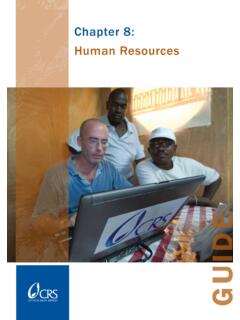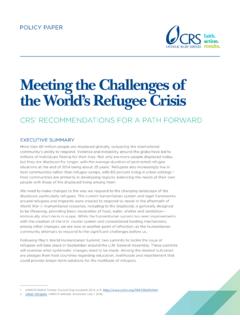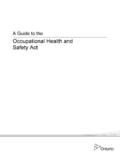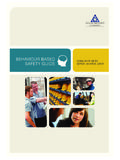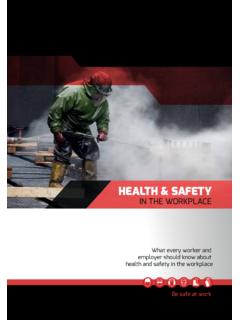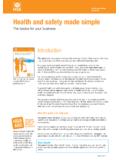Transcription of Health, Safety, and Nutrition - CRS
1 health , safety , and NutritionTRAINING FOR EARLY CHILDHOOD CAREGIVERS AND TEACHERSMODULE 6 FACILITATOR GUIDEHEALTH, safety , AND Nutrition iMODULE 6 FACILITATOR GUIDEH ealth, safety , and NutritionTRAINING FOR EARLY CHILDHOOD CAREGIVERS AND TEACHERSThis guide is part of a series of manuals that focuses on six topics in Early Childhood Development (ECD): different programming approaches, basic concepts, assessments, early childhood environments, children with special needs and child protection, and the health , safety and Nutrition of young children. The series was prepared within a three-year CRS-led project called Strengthening the Capacity of Women Religious in Early Childhood Development, or SCORE ECD.
2 Funded by the Conrad N. Hilton Foundation, the project helps Catholic sisters in Kenya, Malawi, and Zambia in their work with children aged 0-5 years and their families. The project is being implemented from January 2014 to December referred to a wide range of documents in preparing this curriculum. Please see Reference Documents section in Module 1 facilitator or resource guide for the full by Selamawit Tadesse, in cooperation with CRS SCORE ECD teamEdited by David SnyderCover photo: Pilarini James, 8 months, is fed by his mother in Chinganga Village near Zomba, Malawi. His mother participates in a CRS project funded by the Hilton Foundation that trains new and expectant mothers in Nutrition and hygiene.
3 Sara A. Fajardo/CRSC opyright 2016 Catholic Relief ServicesAny reproduction, translation, derivation, distribution or other use of this work is prohibited without the express permission of Catholic Relief Services ( CRS ). Please obtain permission from or write to:Catholic Relief Services228 West Lexington StreetBaltimore, MD 21201-3443 USAHEALTH, safety , AND Nutrition iiiTable of ContentsFACILITATOR S guide 6: health , safety , AND Nutrition ..VSession topics ..vSession length ..vSESSION 1: health AND safety OF YOUNG CHILDREN ..1 Learning objectives ..1 Session outline ..1 Materials ..1 Session plan and procedure ..2 Activity 1. Introduction (30 minutes).
4 2 Activity 2. Germs and their effects on health (1 hour & 15 minutes) ..2 Activity 4: Keeping children safe (45 minutes) ..7 Activity 5: Integrated Management of Childhood Illnesses (IMCI): Ideas for working with caregivers (45 minutes) ..8 Closure and session evaluation (15 minutes) ..11 SESSION 2: GROWTH AND Nutrition OF YOUNG CHILDREN ..13 Learning Objectives ..13 CARING FOR THE CHILD S HEALTHY GROWTH AND DEVELOPMENT: WHO-UNICEF TRAINING MANUAL ..13 Closure and Session Evaluation (15 minutes) ..13 APPENDIX ..15 SESSION 3: CONCLUSION OF TRAINING AND POST-TEST ..19 Learning objectives ..19 Session outline ..19 Materials ..19 POST-TEST PLAN AND PROCEDURE.
5 19 Activity 1. Conclusion of the training (30 minutes) ..19 Activity 2. Administering the post-test (60 minutes) ..19 health , safety , AND Nutrition vSESSION TOPICSS ession 1: health and safety of Young Children Session 2: Growth and Nutrition of Young ChildrenSession 3: Conclusion of training and post-testSESSION LENGTHS ession 1: 4 hours & 15 minutesSession 2: 1-3 daysSession 3: 1 hour & 30 minutesFacilitator s guide 6: health , safety , and Nutrition health , safety , AND Nutrition 1 Session 1: health and safety of Young ChildrenLEARNING OBJECTIVESBy the end of this session, the participants will be able to: Describe the effects of germs on health .
6 Identify ways to prevent germs from spreading among children and adults. Describe what Universal Precautions means and the need to use universal precautions all the time when dealing with blood and bodily fluids. Put measures in place to prevent accidents in and around the home or in school. Respond quickly and appropriately to accidents. Describe common childhood illnesses and the danger signs of childhood illnesses that require urgent medical attention. Identify steps that are helpful to prevent or treat childhood illnesses. SESSION LENGTH: 4 HOURS & 15 MINUTESSESSION OUTLINEACTIVITYSUGGESTED TIMEW elcome and introduction30 minutes1.
7 Germs and their effects on health1 hour & 15 minutes2. Understanding and using Universal Precautions 45 minutes3. Keeping children safe45 minutes4. Childhood illnesses: Integrated Management of Childhood Illnesses (IMCI) 45 minutes5. Closure and session evaluation15 minutesTotal4 hours & 15 minutesMATERIALS Name tags and attendance register Plastic bags or latex gloves for each participant Flip book handout A presentation of key points on newsprint or PowerPoint2 MODULE 6 FACI LITATO R G U I D ESESSION PLAN AND PROCEDURESESSION ACTIVITIES Activity 1. Introduction (30 minutes) Have the participants sign an attendance register on arrival and provide them with name tags (5 minutes).
8 Welcome everyone and open the meeting in an appropriate way, such as with a prayer or a song (10 minutes). Play a game or do an icebreaker activity to help the participants relax and get to know each other better (5 minutes). Briefly explain Module 6, Session 1 its purpose, and what the participants are expected to learn from this session by going through the activities listed under the session outline above (10 minutes). Recap the previous modules/sessions (if applicable), and begin session 2. Germs and their effects on health (1 hour & 15 minutes)ACTIVITY HAND WASHING AND ITS IMPORTANCEP reparation A presentation of key points on flipchart on the topics Germs and their effects on health , Hand washing and its importance, and Facilities and materials required for hand washing.
9 Presentation of key points on flipchart on the topics Brushing teeth, Toilets and latrines, Keeping food safe, and Clean water. Plastic bottles with a screw-on cap of the sort that cool drinks come in and the inside tube from a ball-point pen or some other small, stiff, hollow tube. Bring as many as you can. A presentation of key points on a flipchart on the topic Ideas for working with parents and family caregivers on preventing the spread of Start off by asking the whole group what the word Germs means? Define the term Germs and continue the discussion emphasizing that sanitation and cleanliness is the best way to prevent germs from spreading and every adult has to practice it every day and teach it to young children all the time.
10 Discuss the idea of sanitation and cleanliness using the quizzes below: Read aloud each of the quizzes below and ask the participants to give you the answer. Provide your feedback by using the facilitator s note below and the information from this session: health , safety , AND Nutrition 3 NOTE FOR THE FACILITATOR:Answer keyQuizzes:True or False?1. In an ECD center the most important steps caregivers can take to avoid spreading germs and illnesses among children and adults is regularly wiping children s runny Feedback: It is by making sure each child and adult washes his/her hands frequently2. Children and adults need to learn procedures for proper hand washing.

